William G. Preston
William G. (Gibbons) Preston (September 29, 1842 – March 26, 1910) was an American architect who practiced during the last third of the nineteenth century and in the first decade of the twentieth. Educated at Harvard University and the École des Beaux-Arts in Paris.,[4] he was active in Boston, New York, Rhode Island, Ohio, New Brunswick and Savannah Georgia where he was brought by George Johnson Baldwin to design the Chatham County courthouse. Preston stayed in Savannah for several years during which time designed the original Desoto Hotel (1890, demolished 1965[5]), the Savannah Volunteer Guards Armory and 20 other distinguished public buildings and private homes.[6] He began his professional career working for his father, the builder and architect Jonathan Preston (1801–1888), upon his return to the United States from the École in 1861, and was the sole practitioner in the office from the time his father retired c. 1875[7] until he took John Kahlmeyer as a partner in about 1885.[8] The drawings of the Preston firm, now owned by the Boston Public Library, make up "...one of the most complete sets of architectural graphics preserved from the nineteenth century."[9] Many of his buildings were pictured as prints in American Architect and Building News. He is credited with the introduction of the bungalow to the United States through a house loosely of the type that he designed in Monument Beach, Massachusetts in 1879.[10] Preston was an early historic preservationist. He was influential in the successful 1896 effort to prevent the Massachusetts state legislature from demolishing Boston’s historic State House,[11] which had been designed by the noted architect Charles Bulfinch and built in 1798. Bulfinch was also an architect of the Capitol building in Washington, D.C.[12]
William Gibbons Preston | |
|---|---|
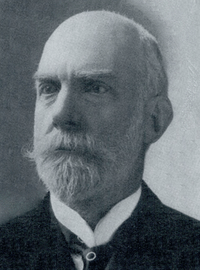 | |
| Born | September 29, 1842 Boston, Massachusetts, U.S. |
| Died | April 26, 1910 (aged 67) [1] Brookline, Massachusetts, U.S. |
| Nationality | American |
| Occupation | Architect |
| Buildings | See below. |
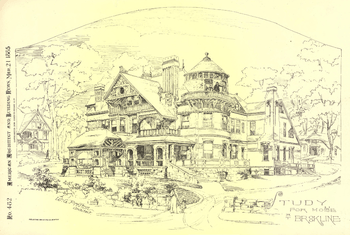
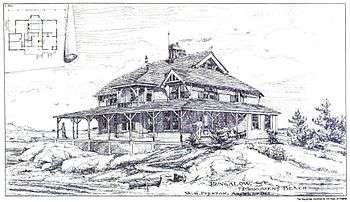
Preston ran his practice for many years from a commercial and office building located at 186 Devonshire Street.[13] He designed Massachusetts Institute of Technology's Rogers Building in 1864, located on Boylston Street near Boston's Copley Square, which housed the school's architecture department. Floor plans for the building show a large, centrally located space devoted to an architectural library and museum. Drawings from the Study Collection were hung on the studio walls and numerous casts and other artifacts also lined the walls and picture rails.[14]
Preston married Estelle M. Evans (1847–1920[15] ), whose father was the wealthy real estate developer Brice S. Evans,[16] on December 6, 1866, and the couple had one son, Evans (1867–1900). William was an active member and fellow[17] of the American Institute of Architects and served that organization in the office of first vice-president at the end of the 1890s.[18] He was for many years a member of the Boston Society of Architects, and for thirty years served as its treasurer.[19] He died at his home at 1063 Beacon Street[20] in Brookline in 1910.[21]
Selected projects
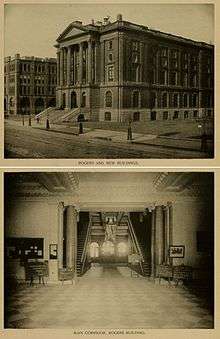
- Rogers Building of the Massachusetts Institute of Technology, (1864, demolished 1939) 491 Boylston Street, Boston MA., with his father Jonathan Preston[22]
- New England Museum of Natural History (1865, with Jonathan Preston, extant) 234 Berkeley Street, Boston, MA – after a fifteen-month restoration in 2013 now RH Boston.[23]
- The Old Boston Coliseum, (completed June, 1869, flattened by a series of windstorms on November 20, 1869 as it was being dismantled for scrap)[24] Dartmouth Street and St. James Avenue, Boston, MA
- Charles Edward Cook house (c. 1870 – extant) 1 Gloucester St., Boston, MA[25]
- Hotel Vendome (1871 – extant) 160 Commonwealth Avenue, Boston, MA, corner section by Preston, remainder by J.F. Ober and R. Rand in 1881
- George H. Fales house (1873 – extant) 27 W. Main St., West Brookfield, MA
- Massachusetts State Prison – Third Place winning entry, (1874)[26]
- Moody and Sankey Tabernacle, Tremont Street, Boston, MA (1876,[27] demolished c. 1883) now the site of Boston Center for the Arts
- Thomas–Webster Estate, main house (1878 – extant) 238 Webster Street, Marshfield, MA
- Exhibition building at Rio de Janeiro (1878 – status unknown)[28]
- Charles H. Bradshaw house, (1878, extant) 175 Summer Street, Spring Hill (Somerville), MA[29]
- Police Station and Jail, (1878, demolished c.1975) 128 King Street E., Saint John, New Brunswick, Canada[30]
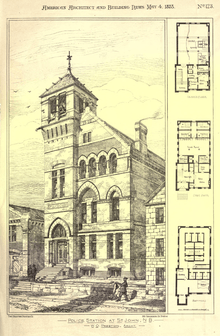 Police station, 1878, Saint John, New Brunswick
Police station, 1878, Saint John, New Brunswick - Bungalow (1879 – status unknown) address unknown Monument Beach, MA
- Mason Building, Liberty Square, (1880 – demolished) 70 Kilby Street, Boston[31]
- Proposal for an International Exposition Building for the 1883 New York World's Fair[32] (1880 – fair never held)
- Massachusetts Charitable Mechanic Association building (1881, demolished 1959) Huntington Avenue and West Newton Street, Boston, MA[33]
- Pavilion at Friars Head (1882 – status not known) Campobello, New Brunswick
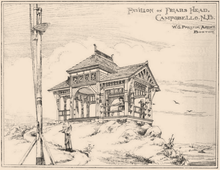 Pavilion at Friars Head,1882, Campobello, New Brunswick
Pavilion at Friars Head,1882, Campobello, New Brunswick - Jacob Sleeper Hall, Boston University, (1883, demolished) 688 Boylston Street, Boston, MA
- The Hotel Aubry (1883, demolished 1959) 149 Newbury Street, Boston, MA (W.G. Preston & Albert C. Fernald)
- Lincoln Public Library[34] (1884, extant, with subsequent additions by others) 3 Bedford Road Lincoln, MA
- Claflin Building (1884, extant), 20 Beacon Street, Boston, MA, renovation of an 1873 building by others as the building for the Boston University School of Religious Education and Social Service, named for university founder Jacob Claflin. Alexander Graham Bell taught vocal physiology in the building. It has also held retail businesses and is now a residential condominium building.[35]
- Boston Terra Cotta Company's "New Building"[36] (1885, demolished) 394 Federal St., Boston MA

- Savannah Cotton Exchange (1886, extant) 100 E. Bay Street, Savannah GA
- Greene's Inn (1887,[37] – burned c.1980 and subsequently demolished[38]) 175 Ocean Road, Narragansett Pier, RI
- George Johnson Baldwin house (1887, extant)[39] – 225 E. Hall, Savannah, GA. This house is notable for its "...tall ribbed chimneys and the elaborate stepped dormer(s)."[40]
- Chadwick Lead Works, (1887, extant) 176–184 High Street, Boston[41]
- "Gardencourt" Charles H. Pope house (c. 1888 – extant) 10 Gibson Avenue, Narragansett Pier, RI [42] now expanded and converted to a condominium community.
- Union Society Building (1889, extant)[43] 121–125 Whitaker St., Savannah GA
- Chatham County (GA) Courthouse (1889, extant), 124 Bull Street, Savannah, GA
- Hotel De Soto (1890,[44] demolished 1968[45]), E. Liberty Street at Drayton Street, Savannah, GA, now the site of the Hilton DeSoto Hotel.
- Charles M. Russell mansion[46](1890 – demolished in 1966 and replaced by a Goodyear store[47]) 328 Lincoln Way East, Massillon, OH
- St. Luke's Lutheran Church[48] (1890, extant) Marlon Avenue and Park Avenue West, Mansfield, OH. Repurposed as a home.
- Francis H. Dewey house "Stonecroft" (1891 – extant) 362 Ocean Road, Narragansett Pier, RI [49]
- Marion Music Hall (1891 – extant) 164 Front Street, Marion, MA[50]
- Armory of the First Corps of Cadets of the Massachusetts Volunteer Militia[51] (1891, completed 1897, extant), 97–105 Arlington Street, Boston, MA, pictured in August 20, 1892, American Architect and Building News
- John Hancock Building (Devonshire) (1891, demolished c.1903) 178 Devonshire Street, Boston, MA[52]
- Savannah Volunteer Guards Armory, (1893, extant) 90–92 (now 342) Bull Street, Savannah, GA, now Poetter Hall, Savannah College of Art and Design.
- Central Exchange Building, (c.1895 – extant) 340 Main Street, Worcester, MA
- Templeton Farm Colony of the Massachusetts School for the Feeble-Minded (Now Templeton Developmental Center), (1899, extant) 126 Royalston Road, Templeton, MA
- Boston Transit Commission Building (1903, extant) 15 Beacon Street, Boston, MA
- Dormitories and Electric Plant for the Massachusetts School for the Feeble-Minded[53] (after 1925 the Walter E. Fernald State School), (1902, 1905, extant), 200 Trapelo Road, Waltham, MA
- International Trust Company Building (1906 – extant) 45 Milk Street, Boston, MA, substantial expansion of existing building by others.[54]
- Quincy Market Cold Storage Warehouse (1906,[55] demolished) 21–33 Eastern Avenue, Boston, MA
- Barn for the Massachusetts State Sanatorium[56] (1908, demolished) State Hospital Road, Rutland, MA
- Central Station of West End Street Railway Company, Boston
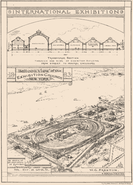
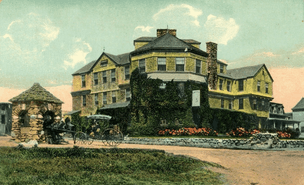

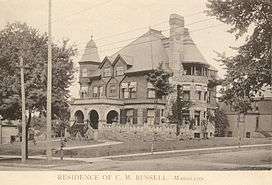
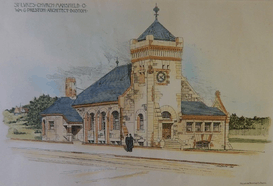

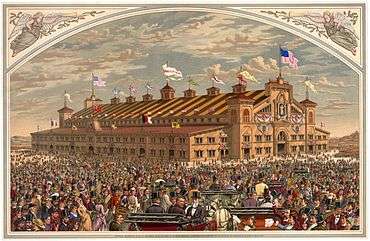
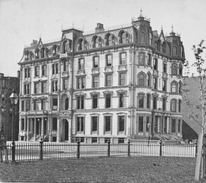
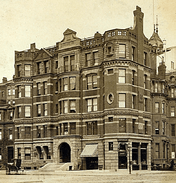
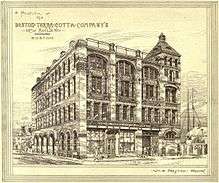
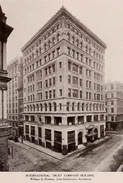
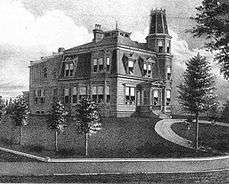


_public_library_1884_George_Nelson%2C_photographer.png)

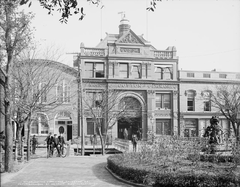
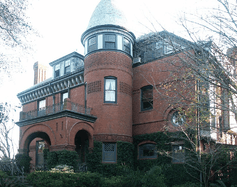
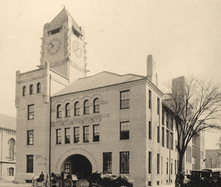
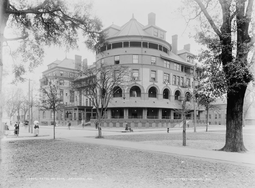
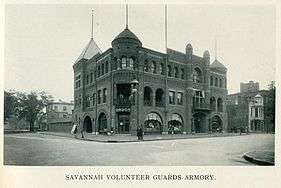
References
- "Obituaries - William Gibbons Preston". American Institute of Architects Quarterly Bulletin. XI (1): 35. April 1910.
- Hardwicke, Greer and Roger Reed (1998). Brookline. Charleston: Arcadia Publishing. pp. 73. ISBN 978-0-7385-4974-3.
- "The Illustrations – Bungalow at Monument Beach, Mass., Mr. W.G. Preston, Architect, Boston". American Architect and Building News. VII (222): 129. March 27, 1880.
- "Mechanic's Hall Designer Dies". Boston Journal: 9. April 8, 1910.
- Triplett, Whip Morrison (2006). Postcard History Series – Savannah. Charleston: Arcadia Publishing. pp. 10–14. ISBN 0-7385-4209-1.
- Caldwell, Wilber W. (2001). The Courthouse and the Depot: The Architecture of Hope in an Age of Despair – A Narrative Guide to Railroad Expansion and its Impact on Public Architecture in Georgia – 1833–1910. Macon: Mercer University Press. p. 64. ISBN 0-86554-748-3.
- O'Gorman, James F. (1989). On the Boards: Drawings by Nineteenth-Century Boston Architects. Philadelphia: University of Pennsylvania Press. pp. 376–377. ISBN 0812212878.
- "Obituary – William Gibbons Preston". The Western Architect. XVI (1): 76. July 1910.
- O'Gorman, James F. (1989). On the Boards: Drawings by Nineteenth-Century Boston Architects. Philadelphia: University of Pennsylvania Press. p. 39. ISBN 0812212878.
- Barbara Mayer – The Associated Press (June 20, 1997). "The Bungalow Makes a Comeback". The Salina [Kansas] Journal: A5.
- "THREE-CENT FARE – Representative Mellen Says West End Can Afford Them. – COMPANY SAYS IT IS NOT SO – Last Free Transfer Hearing Will Be Given Thursday. – MORE BOSTON LEGISLATION". Boston Post: 8. April 7, 1896.
- Risjord, Norman K. (2001). Representative Americans: The Revolutionary Generation. Lanham: Rowman & Littlefield Publishers. pp. 161, 167–69. ISBN 1461641985.
- The Boston Directory – Containing the City Record, A Directory of the Citizens, and Business Directory – No. LXXVII – Commencing July 1, 1882. Boston: Sampson, Davenport and Company. 1882. p. 1131.
- Architecture at MIT, accessed August 12, 2010, includes photos
- "Deaths". The Boston Globe. XCVII (117): 13. April 26, 1920.
- Herndon, Richard and Edwin M. Bacon (1896). Men of Progress: One Thousand Biographical Sketches and Portraits of Leaders in Business and Professional Life in the Commonwealth of Massachusetts. Boston: New England Magazine. pp. 960–61.
- "A Group of American Architects". American Architect and Building News. XV (425): 75. February 16, 1884.
- "MEN WHO MAKE PLANS – AMERICAN INSTITUTE OF ARCHITECTS HERE – PROTRACTED PRELIMINARY SESSIONS YESTERDAY AND TO-DAY – Contentions to be Adjudicated before Convention Can Meet". Detroit Free Press. 63 (4): 7. September 28, 1897.
- "Chapter Notes - Boston Chapter". American Institute of Architects Quarterly Bulletin. XI (1): 10. April 1910.
- Rich Adams (June 1915). "MCMA History". Charitably Speaking: 2–3.
- American Art Annual, Volume 8. MacMillan Company. 1911. p. 400.
- "Summary: Henry Parfitt; Jonathan Preston; James Jackson Jarves, lately deceased – The Lockout of the Iron-Workers – The Congressional Library – Architects and Engineers". American Architect and Building News. XXIV (65): 13. July 14, 1888.
- Raul Barreneche (May 2013). "Restoration Hardware's Boston Flagship Store Opens in a Historic Building – After two years of planning and major renovations, Restoration Hardware—newly rebranded as RH—opens its largest store to date in a historic 1860s building". Architectural Digest: 64–65.
- from The Boston Evening Transcript (November 22, 1869). "The Last of the Boston Coliseum – The Great Gale Finishes the Great Bore". The New York Herald. XXXIV (326): 10.
- "An Elegant Double, Octagon Front, Three Story and French Roof Dwelling House – On the Corner of Beacon and Gloucester Streets". Boston Post. XCVI (118): 3. May 17, 1879.
- "The New State Prison". Boston Post. LXXXVI (68): 3. March 20, 1874.
- "Moody and Sankey in Boston". Fitchburg [Massachusetts] Daily Sentinel. IV (188): 2. October 16, 1876.
- "A New Commercial Project". Boston Post. XCV (29): 3. August 3, 1878.
- "House for Charles H. Bradshaw, Esq., Spring Hill, Mass. W.G. Preston, Architect". American Architect and Building News. III (108): 22. January 19, 1878.
- "Police Station at St John, N.B.". American Architect and Building News. 3 (123): 157. May 4, 1878.
- "Mason Building, Liberty Sq., Boston W.G. Preston, Architect". American Architect and Building News. VIII (238): 30. July 17, 1880.
- "The Illustrations – Sketch for the New York International Exposition Building, 1883, Mr. William G. Preston, Architect, Boston". American Architect and Building News. VII (220): 106. March 13, 1880.
- "THE FOURTEENTH EXHIBITION OF THE MECHANIC ASSOCIATION – History of the Association – Its work and Its Prosperity – Previous Exhibitions – Its Officers for Eighty-Seven Years – Present Membership, Etc". Boston Post. CI (64): 5. September 13, 1881.
- "The Illustrations – Lincoln, Mass., Town Library". American Architect and Building News. XV (429): 120, 126. March 15, 1884.
- Boston Real Estate Observer: Claflin Building at 20 Beacon Street, accessed August 12, 2010
- "A Portion of the Boston Terra Cotta Company's New Building -– Boston – Wm. G. Preston, Architect". American Architect and Building News. XVII (497): 7. July 4, 1885.
- Tolles, Bryant Franklin (2008). Summer by the Seaside: The Architecture of New England Coastal Resort Hotels, 1820–1950. Lebanon: University Press of New England. p. 50. ISBN 978-1584655763.
- "Historic Resources of Narragansett Pier" (PDF). Rhode Island Preservation. Retrieved 2014-10-21.
- Regina Cole (Spring 1997). "Savannah Grace – In a City Famous for Old Houses, this one is a Landmark". Old House Interiors. III (I): 34.
- "webpage 225 East Hall (or the George Baldwin House) – page 1 (of two pages), William Gibbons Preston, 1887". Mary Ann Sullivan for Bluffington University. Retrieved 2016-11-30.
- "Chadwick Lead Works – Boston – Mr. W.G. Preston, Architect – Boston, Mass". American Architect and Building News. XXI (193): 223. May 7, 1887.
- Narragansett Pier – Narragansett, Rhode Island – Statewide Historical Preservation Report: Rhode Island Historical Preservation Commission, Mrs. George E. Downing, Chairman, February, 1978, p.14
- HABS Document No. GA-1203 A
- Multiple print spread including main entrance, dining room, and exterior May 2, 1896, American Architect and Building News
- Horace Sutton (October 6, 1968). "Historic Foundation Restoring Savannah's 19th Century Charm". Chicago Tribune: J13.
- "Our Architectural Illustrations". The Engineering and Building Record and Sanitary Engineer. 22 (8): 114, 114a. June 26, 1890.
- "The C.M. Russell Mansion...will be razed". The [Massillon] Evening Independent. CII (297): 3. June 22, 1965.
- "The Illustrations – St. Luke's Church, Mansfield, O., Mr. W.G. Preston, Architect, Boston, Mass". American Architect and Building News. XXVII (744): 205. March 29, 1890.
- Narragansett Pier – Narragansett, Rhode Island – Statewide Historical Preservation Report: Rhode Island Historical Preservation Commission, Mrs. George E. Downing, Chairman, February, 1978, p.35
- Rosbe, Judith Westlund (2000). Marion. Charleston: Arcadia Publishing. pp. 23. ISBN 9780738504193.
- "The Illustrations – Armory of the First Corps of Cadets, Boston, Mass., Mr. W.G. Preston, Architect, Boston, Mass". American Architect and Building News. XXXVII (869): 122. August 20, 1892.
- "BUILDERS FOR ALL TIME – AMERICAN INSTITUTE OF ARCHITECTS IN ANNUAL SESSION – HON. A.J. CALDWELL VOICES THE CITY'S WELCOME – Many Interesting Papers and Reports Read and Discussed – The Programme – Some of the People Here". The Nashville American. XXI (7287): 3. October 21, 1896.
- Turner, Henry E. (1907). Report of the Auditor of Accounts of the Commonwealth of Massachusetts, for the Fiscal Year (eleven months) ending November 30, 1906. Boston: Wright and Potter Co., State Printers. p. 430.
- "Reconstructions". The Western Architect. XIV (4): 33–34. October 1909.
- "The New Quincy Market Cold Store". Cold Storage and Ice Trade Journal. XVI (2): 29–31. August 1906.
- Turner, Henry E. (1909). Report of the Auditor of Accounts of the Commonwealth of Massachusetts, for the Fiscal Year ending November 30, 1908. Boston: Wright and Potter Co., State Printers. p. 347.
Further reading
- City of Boston, Landmarks Commission. International Trust Company Building (45 Milk Street) Study Report, 1977. (Building designed by Preston)
- Jean Ames Follett-Thompson: "The Business of Architecture – William Gibbons Preston and Architectural Professionalism in Boston in the Second Half of the Nineteenth Century," Ph.D. diss., Boston University, 1986
External links
| Wikimedia Commons has media related to William G. Preston. |
- Boston Public Library. William G. Preston (1842–1910) Collection
- New York Public Library. View of the Coliseum, World's Peace Jubilee and International Musical Festival, 1872 (designed by Preston)
- http://communities.aia.org/sites/hdoaa/wiki/Wiki%20Pages/ahd1035887.aspx
- Hotel Vendome. Preston designed the corner building, 1871
- Poetter Hall historical marker
- The Next Phase Blog – Social commentary and opinions: No guns, politics, or religion. Boston’s Hidden Gems: New England Museum Restoration – This is the seventh in a series of posts on largely unknown spaces in Boston that are open to the public.
- 225 East Hall (or the George Baldwin House) – Page 1 (of two pages), William Gibbons Preston, 1887, Mary Ann Sullivan, Bluffington University
- International Trust Company Building – 45 Milk Street, Boston – Boston Landmarks Commission Study Report
- Lost New England – Hotel Vendome, Boston
- PHOTOS, PRINTS, DRAWINGS – Savannah Historic District, Whitfield Building (Union Society Building), 121–125 Whitaker Street, Savannah, Chatham County, GA
- Charitably Speaking - "MCMA History"